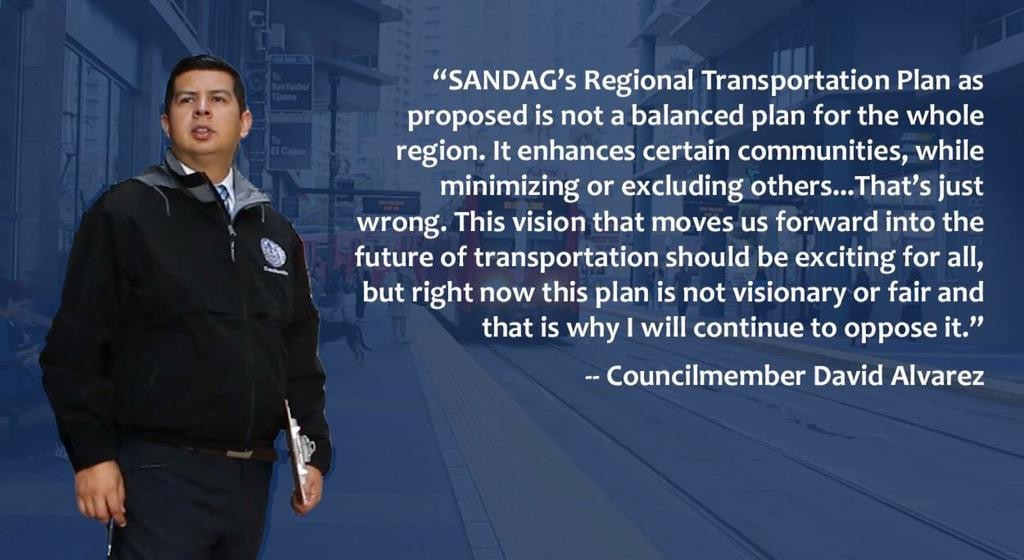San Diego County Spends $36M To Give Employees Free Parking
The San Diego County Board of Supervisors recently cut the ribbon to officially open a new $36,000,000 parking garage at Cedar and Kettner in Little Italy. The garage has 640 spaces, built at a cost of $56,250 per space. The garage will primarily be used for free parking for county employees and will also be available for paid public parking use on nights and weekends.
Here’s a laudatory video from the ribbon-cutting:
Supervisor Diane Jacobs noted “this truly is the best looking parking garage in the entire region and the most needed parking garage”. The “stalls are a little wider than you’ll find in most commercial parking structures”.
The Little Italy neighborhood is home to many of San Diego’s most highly regarded restaurants including Bracero, Buon Appetito, Monello, Ironside, Davanti Enoteca, Juniper and Ivy, and many others. Most of the restaurants have little, or zero, private parking provided. The area has also seen tremendous growth in the number of residential units in recent years. The result has been a thriving neighborhood that is among the most vibrant places in the entire county. A large part of the enjoyment of Little Italy stems from the many people and attractive buildings present – I doubt India Street would be improved by the addition of a massive parking garage. In recent years the need for parking of unused vehicles has been further reduced due to the explosive growth of taxi-hailing apps like Lyft and Uber.
The new county parking garage is the second portion of the “Waterfront Park project” that created a 12-acre park across Harbor Drive from San Diego Bay, replacing 8 acres of surface level parking lots adjacent the County Administration Building. That project cost $49.4 million dollars after an initial project cost estimate of $44.2M with $19.7M for building the park, $18.5M for building underground parking, and $6M for design and administration costs.
In total, between the two projects $54.5M was spent on moving parking spaces and $18.5M was spent on the actual park that people enjoy. This is excluding the $5.2M of difference from the original estimate to the actual construction costs and the $6M of design and administration costs. Those cost breakdowns yield a result of 75% of funds used to move spots for empty cars and 25% of funds used to build a park. For purposes of this article let’s assume the admin and cost over-run figures split on the same lines. The vast majority of the funds used for these joint projects was for moving parking spaces, not for building a park.


This project was sold as a project to build a great park – it would seem fitting if most of the funds were actually used to build a great park. Instead we spent 75% of the funds to relocate parking spaces, not creating new spaces but moving existing parking spaces. 251 spaces moved approximately 15 feet, they were undergrounded in the same location as the previous surface level lots.
To boot, the county demolished an historic building in Little Italy to make room for the large new parking garage. The Star Builders Supply Company building was built in 1911 and added to the county list of historic buildings in 1991. County supervisors unanimously voted to demolish the building. It’s now gone but you can enjoy the below video of the beautiful piece of San Diego history that has now been erased like so many others.
From the total 891 parking spots that were moved, 71.8% were moved about 1-2 blocks east from their previous location. 28.2% were moved about 15 feet underground. To accomplish this feat, county taxpayers spent $54.5 million dollars. As enjoyable as the the new park is and a huge improvement to the ugly surface parking lots perhaps it would have been better to save that money or spend it on a better use. To move so many parked cars such a small distance seems a pyrrhic victory. A small consolation might be that the total number of parking spots went from 1,200 in the surface lots to 891 in the new underground and multi-level parking garages, a net reduction of 25.75%. We could have spent even more money if we moved all of them! A legitimate question would be if the previous 1,200 spots or the new 891 spots are actually needed or not. But as so often happens when it comes to accommodating automobiles, too much is never enough and no cost is too high. More lanes on I-5 for $6 billion? Of course! More parking lots in Balboa Park? Of course! Analysis of the actual demand and cost comes far behind the populist appeal of free goodies for motor vehicles. The environmental impacts of our car culture is even further down the priority list than our dollars.
Enjoy the Waterfront Park (aka Parking Lot Relocation Park); it’s a great place. Building beautiful things is something a great city does. I’m proud that San Diego built it. In total, though, this project was a massive use of taxpayer dollars to move parking spots a small distance – not to build a great public park. They are distinct items and taxpayers did not need to spend tens of millions to provide a tax-free employment perk that most employees, government-employed or not, do not enjoy. We also did not need to use prime real estate to do so. Taxpayers must demand better stewardship of public funds and assets.
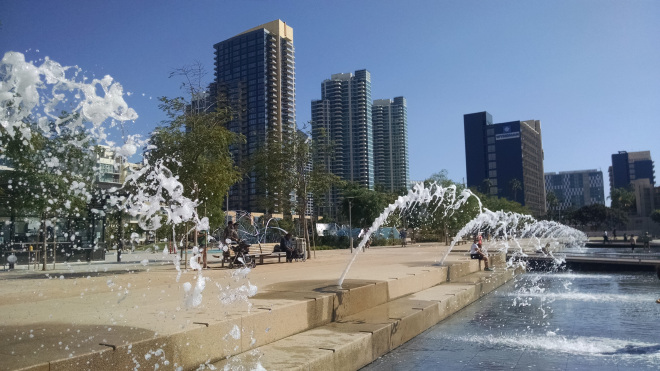

Previously posted here.
A Bike Route Network Appears in Old Town
Since the first shared lane markings appeared in Old Town about four years ago, some more changes have slowly appeared making Old Town, California's birth place, just a little bit more bike friendly than it has been for decades. Below is a drawing of the start of a bike network starting at the Old Town Transit Station.
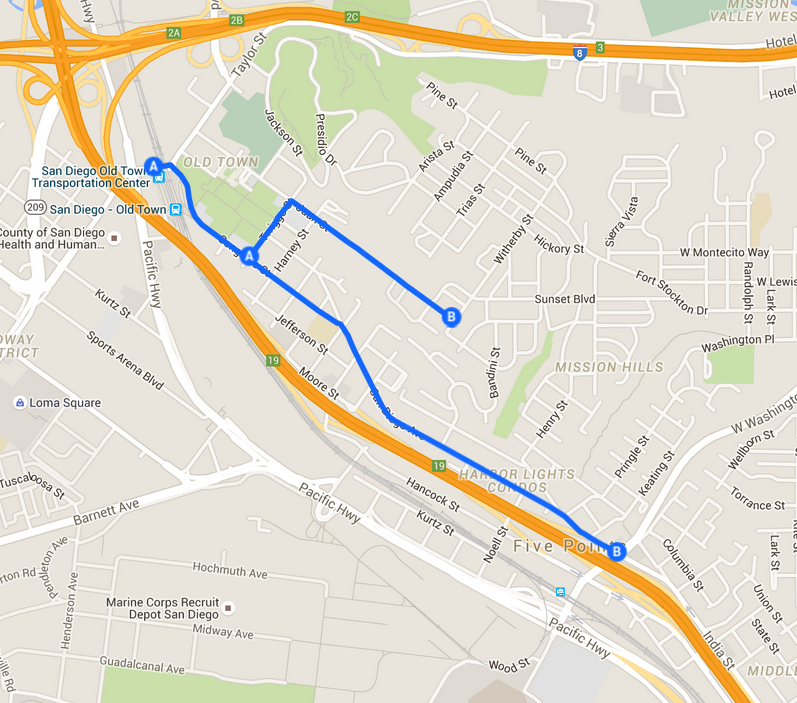
Below are a few photos of the bike route from Old Town and into Middletown (at the bottom of Washington St)
View toward Old Town Transit Station, a transit hub at Congress and Taylor Streets. Congress St has shared lane markings(sharrows)
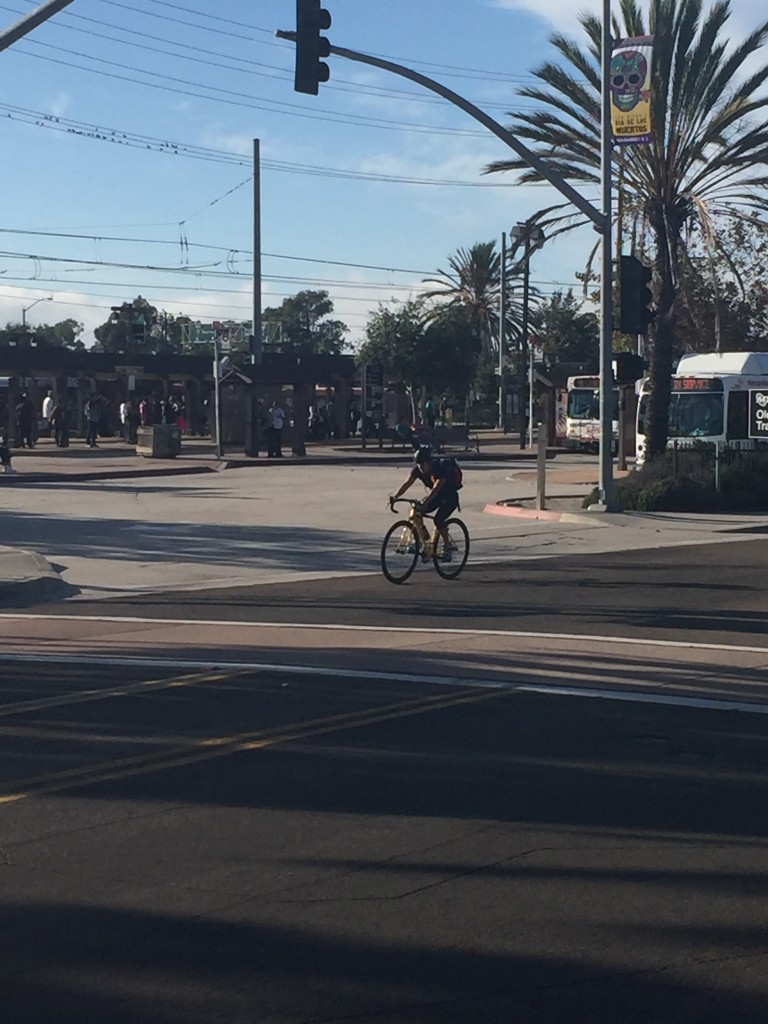
And yes, Juan Street (one of the routes up to the Central Mid-City mesa) is in terrible shape. The good news? It's finally getting fixed.

Going up or down the steep Juan Street will soon be better. Today it is pretty terrible.

From the city's new City of San Diego - Juan Street Improvement Project facebook page: "Recent activity on the Juan Street Improvement project... newly poured concrete on the northbound side from Taylor to Mason Street and grading of the new road, curb and gutter between Mason and Twiggs. All businesses and parking lots are open during the project. Visit historic Old Town!" Hooray for more communicative city departments!
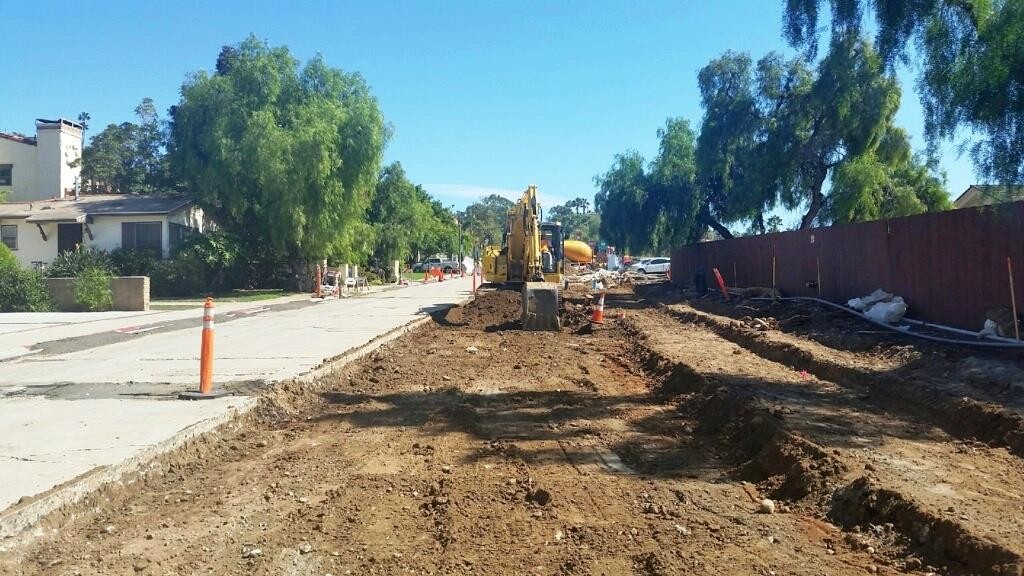
Our favorite hi-viz wearing individuals pour concrete and repave city streets.
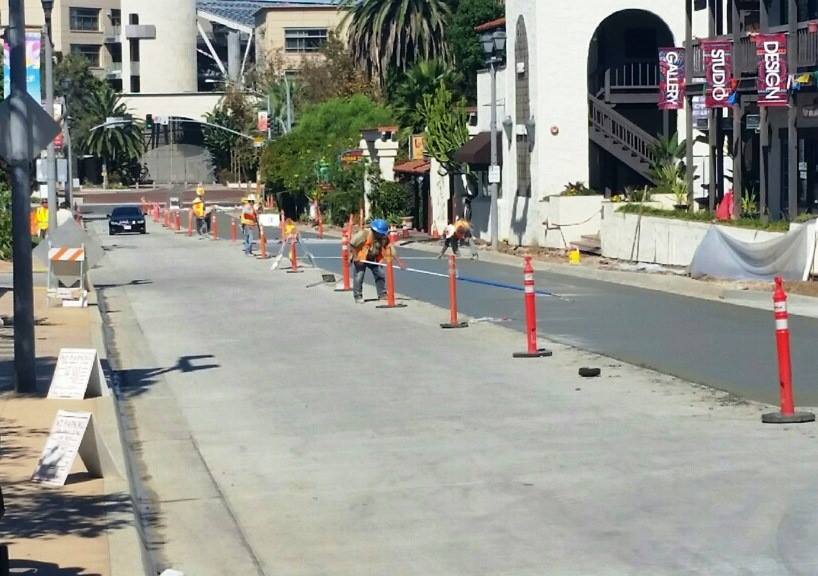
Besides Presidio, the other option to get up to the mesa is either along the speedy Washington Street (posted speed limit is 45 mph, if anyone actually pays attention - law enforcement help is more than welcome to address this safety issue), or along Presidio through Presidio Park. But another option is along San Diego Avenue and up Pringle Street which parallels Washington (it is steep, no question, but a little bit quieter)
First, one would ride north on Congress following the sharrow symbols
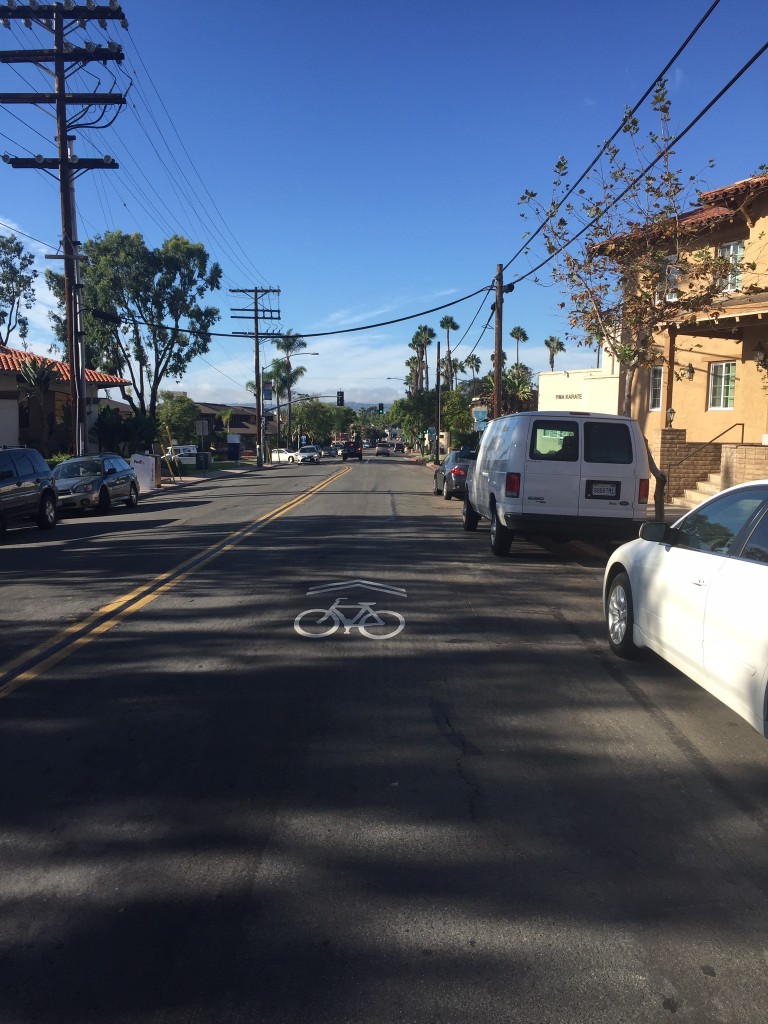
Then you'd turn onto San Diego Avenue where a portion of the street has striped bike lanes:
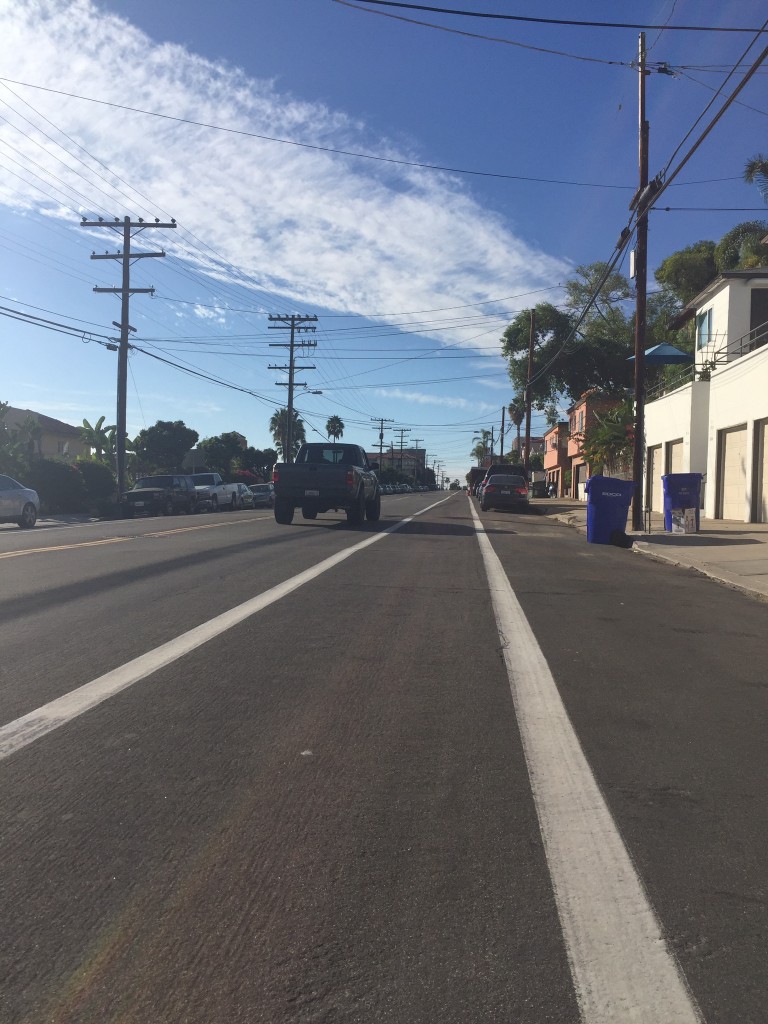
While the entire city of San Diego needs a lot of work to make it a world-class city to ride a bicycle in, it is gratifying to see changes happen even if it comes at a very (very) slow pace.
Bike SD – The Board Retreat
Reposted from the S&G Endeavors Blog.
If you missed it earlier this week, you may want to go back to revisit the first post in this blog series. You may recall the story of Bike SD, a bicycle advocacy organization in San Diego. Last week, we learned about how they launched about three years ago, grew quickly, defined their brand, and how they desired to transform into a strategically-effective and more professional powerhouse to serve all people who bike in San Diego. BikeSD: Working to be World Class
Building on the willingness of the board of directors to use their gumption and passion to help take BikeSD forward, they embarked, in February 2015, on a process to craft a concrete strategic plan with clear actions and initiatives to take Bike SD to the next level as an organization. The group was ready to really dive in and to have a dialogue centered around what was next.
The excitement from Sam Ollinger, who was responsible for leading the organization, was also compelling. She knew that this process would leave them with a clear shared strategic plan to move forward. The process for bringing organizations together to create a shared strategic plan is unique to each organization. Let’s examine some of the events that occurred for BikeSD as part of the process of planning and hosting their retreat.
Designing the Retreat
Over the course of three virtual conversations, the design team, comprised of 5-7 board members representing the whole system, met to design the conversation and identify the overall purpose & outcomes that they wanted for the retreat. 
The most important part of creating any type of event like this is to be clear with the purpose and outcomes for bringing people together. A clear purpose and outcomes ensures that you are clear with your reason for meeting and what you want to achieve, together as participants, during the meeting. The following are the purpose and outcomes, as crafted by the design team:
Purpose
The purpose of our retreat is to come together as a committed board and key stakeholders to both grow bicycling in San Diego and to ensure that we have a strong, dedicated, leadership that buy-in to and will support our determined course for BikeSD.
Outcomes
We will create a common understanding of the opportunities and challenges facing BikeSD with respect to advocacy, political engagement, membership engagement, funding, working with other organizations, and other issues.
We will foster a sense of unity among the board and other stakeholders of BikeSD, creating an environment of cooperation with a common purpose around a new strategic framework.
We will leave with a viable strategy for the success of a strong BikeSD, which creates organizational sustainability; transforms cycling in our city; and, has prioritized, measurable, and concrete action plans to ensure that we are true to the vision.
We will leave with the knowledge that we have all been part of the decision-making process, are focused, and know what we have to do to succeed.
In addition to identifying the overall direction for the retreat, the design team members worked, with the help of S & G, to:
- Ensure the retreat was designed to make the best use of their time;
- Identify strategies to ensure enough people would come and share their wisdom; and,
- Design the right conversations and retreat experience that resulted in achieving their aims of the retreat.
Holding the Retreat
 On April 17 and 18, the board members of BikeSD met for their retreat and had great success with their work together. Friday night kicked off with a collaborative activity, where participants introduced themselves and the group was able to bond over a more cohesive visioning exercise for the organization. On Saturday, the board and some key additional stakeholders continued to build on their visioning from the night before, by brainstorming around specific areas of potential action, confirming a strategic framework to guide the organization, and creating specific action plans to achieve their goals.
On April 17 and 18, the board members of BikeSD met for their retreat and had great success with their work together. Friday night kicked off with a collaborative activity, where participants introduced themselves and the group was able to bond over a more cohesive visioning exercise for the organization. On Saturday, the board and some key additional stakeholders continued to build on their visioning from the night before, by brainstorming around specific areas of potential action, confirming a strategic framework to guide the organization, and creating specific action plans to achieve their goals.
Through evaluations, participants reported that the energy in the room was great. The dialogue they had on the projects that they felt mattered most was so moving, it was difficult to get through the scheduled discussions. Other successes with the retreat, reflected in evaluations and follow-up interviews, included:
- Focusing on our priorities
- Becoming aware of new ideas, strategies
- Realization of what it will take to move Bike SD to the next level
- The future structure of BikeSD as an organization
Following the retreat, the executive director also met with some key additional stakeholders, allies, and funders to report back on the retreat and incorporate any further feedback into the final strategic framework and action plans. Over the next years, Bike SD will be working on just some of the following action, including:
- Increasing and targeting Advocacy Campaigns to increase cycling in the city of San Diego;
- Encouraging frequent riding through events, organized rides and outreach efforts;
- Integrating biking into the San Diego identity and everyday activities of people who bike in the city; and,
- Increasing public & political support for bicycling.
 Through all of the collaborative planning work described above, Bike SD had its key stakeholders had charted an actionable course for success, and through our follow-up discussions, we’re already hearing about great success relating back to the retreat and its design.
Through all of the collaborative planning work described above, Bike SD had its key stakeholders had charted an actionable course for success, and through our follow-up discussions, we’re already hearing about great success relating back to the retreat and its design.
Stay tuned to the third blog, next week, when we hear directly from their Executive Director about their recent successes.
And be sure to contact Jeremy for an initial conversation soon, so that S & G can help your organization or company achieve actionable change in 2016 and beyond.
Bike San Diego – Working to be World Class
Reposted from the S&G Endeavors Blog.
Editor’s Note: The title is not deceiving. One of our collaborative strategic planning clients, Bike San Diego (BikeSD), is challenging themselves to work more collaboratively as an organization, and with other partners, to bring a world-class cycling experience to San Diego, California. Armed with a strong public presence through their blog, advocacy wins, outstanding executive director, and skillful board members and stakeholders, they have positioned themselves to be one of the top cities for cycling in the world by 2020. It was so exciting to work with BikeSD and their stakeholders to facilitate a conversation setting the stage for the future of the organization and for cycling in San Diego.
The below blog post, written by Sam Ollinger (executive director of BikeSD), is the first in a series of three posts that tells the BikeSD story.
First, Sam helps us understand what spawned the creation of BikeSD and how they experience significant growth and legitimacy in their first years, urging them to come together as leaders to think about what was next for the organization and its mission. The second post takes an inside look at their strategic retreat facilitated by S & G in March 2015, specifically highlighting feedback from participants and the process used. In the final post, we feature the future of the organization as we take a look at their launched strategic action plan and some of the current activities they are doing during implementation.
We encourage you to check out all of these posts and to think about how such work might help your leadership team, as you think about what’s next for your own organization in 2016 and beyond.
The Story of BikeSD
by Sam Ollinger
A Labor of Love
In early 2009, three strangers met on a bicycle ride and began talking about the lack of a cohesive gathering space to talk about bicycling issues. These strangers (Will Karstens, Thom Bahde and me, Samantha Ollinger) went on to found BikeSD.org – a blog that would serve as a single source of news about bicycling in San Diego. Little did I know that BikeSD the blog would eventually turn into one of San Diego’s largest independent member based advocacy organizations.

Karstens, Bahde, and I wrote on BikeSD.org for nearly two and a half years about all bicycling issues: how bicycling was portrayed in local media, the breathtaking beauty one would witness on an early morning ride, the sorts of bike infrastructure that was (or not) being implemented in the city, and more. Slowly the blog became a credible source of information in the San Diego bicycling community. Many strangers assumed that the individuals behind the website were part of a credible organization and none of us bothered to correct that misperception, but instead we embraced it and rose up to become advocates. We appeared in local media, spoke up against dangerous road conditions and told stories of San Diego’s victims of road violence. It seemed that people were hungry for our blog’s information thus creating “a labor of love” for the three of us.
The Birth of the Organization
After Karstens and Bahde both moved away from San Diego, I was unsure about what to do with the blog. In 2012 – two friends, fellow riding companions and occasional blog contributors spoke about converting the blog into a professionalized non-profit advocacy organization. I had no big vision beyond keeping an organization running in an all-volunteer capacity. And with encouragement from a dozen or so close confidants, friends and bike advocates – I decided to commit and steer BikeSD from a blog into a non-profit organization.
 Back in May 2012 when our attorneys filed our incorporation paperwork, I had no idea what I had committed to. My assumption going into this was that I’d show up to a handful of meetings every month and make a case that would be along the lines of “don’t forget about us bicycle riders!” In addition to having to master the micro environment of this type of organization and my own leadership growth; I also had to understand and absorb the dynamics of advocacy. But while I remained the visible head of the organization, what the public couldn’t see were the many, many volunteers and advisors and mentors who guided every step of BikeSD’s and my journey.
Back in May 2012 when our attorneys filed our incorporation paperwork, I had no idea what I had committed to. My assumption going into this was that I’d show up to a handful of meetings every month and make a case that would be along the lines of “don’t forget about us bicycle riders!” In addition to having to master the micro environment of this type of organization and my own leadership growth; I also had to understand and absorb the dynamics of advocacy. But while I remained the visible head of the organization, what the public couldn’t see were the many, many volunteers and advisors and mentors who guided every step of BikeSD’s and my journey.

A year after we launched, I went after every single low-hanging fruit and some far reaching ones too. We got political support for the issue and made bicycling a discussion in the mayoral race, became a city that adopted progressive design guidelines on transforming our streets (NACTO), implemented road diets, and more. Not knowing much about the dynamics of advocacy I approached the issue with a simple idea: what happens if I try and give this my best shot? Advocacy is an imperfect art. It requires dedicated, sustained effort and nerves of steel. Doing this work has been one of the most challenging, most difficult, most gut-wrenching endeavours I have ever attempted. But the work has to be done. Not just for the obvious environmental reasons but simply because bicycling makes our cities better places to live, work, and play.

A Professional Organization
Leading the emergence of BikeSD opened my eyes to a huge hole in our the organization’s advocacy approach – in order to win and attain changes on the ground, we as an organization had to grow and become professionalized. The status quo embedded within our societal culture and our national resistance needed to change
In the spring of 2014, we knew that BikeSD couldn’t sustain itself on the sheer passion and gumption of its many volunteers. We had to become a professionalized organization and begin to incorporate the broader San Diego community into our work. If we were to be successful in meeting our mission we needed to begin the process of professionalizing our organization. We began the process by going through a branding and marketing makeover, creating a business plan, hiring our first staffer and beginning work on our first five year strategic framework. It was time for me to collaborate with my board to set the governance and future direction of the organization.
Are you curious how we brought the leadership together around a common vision and a rapid-paced strategic planning process that resulted in action? Stay tuned to post 2 in this series.
Today: Mayor Faulconer Forgoing Vote on $200 Billion Regional Transportation Plan
 As Voice of San Diego reports,
As Voice of San Diego reports,
Mayor Kevin Faulconer has punted an opportunity to vote on $200 billion in spending on an issue central to his legacy.
That's right, with a $200 billion dollar plan on the table where our city has a 40% stake in - our own mayor has opted to not bother with a vote. He is sending his alternate, Councilmember Zapf who will be voting to support the plan. Yes, despite the plan proposing to implement over 1,700 additional miles of freeways, the mayor still seems to think this is a great plan. Never mind the "Transit First" resolution that the city of San Diego Council passed in 2011 that the plan is failing to implement.
If you read SANDAG staff responses to various organization's requests to prioritize bicycling and walking or implement "transit first" (prior to freeways), the responses repeat one line over and over: that SANDAG does not have land use authority and thus the Regional Transportation Plan cannot dictate land use - or what can be done with land. That is true, SANDAG as a regional planning agency does not have land use authority. However, the SANDAG board is comprised of elected officials from around the county who are ostensibly elected to represent the citizens in their jurisdiction. These elected officials vote on land use matters specific to their jurisdiction. For example, the San Diego City Council voted to give land to Deco Bike Share so the company could place advertisements on public land and raise revenue to support their bike share operations. These elected officials, like Mayor Kevin Faulconer (or Councilmember Lorie Zapf) and Councilmember Todd Gloria are expected to carry out the will of their electorate who expect their electeds to vote on a plan that is a good use of public taxpayer dollars.
The current plan, scheduled for adoption today, is an update of the 2011 plan. The plan scheduled to be adopted today still has all the road projects from 2011. The transit projects from 2011 have been replaced with cheaper projects. In other words, if you thought hoping for an empty bus rack was a temporary problem, SANDAG plans to make this permanent.
While the plan will get adopted today with the vast majority of the board ignoring the overwhelming majority of public speakers who will urge them to vote against the plan, I know one local leader will listen to his constituents and oppose the plan, Councilmember David Alvarez. As he stated on twitter yesterday, "Waiting 35 years for progress in bike/transit/pedestrian infrastructure is not an option."
Thank you Councilmember Alvarez, for being a true leader.

